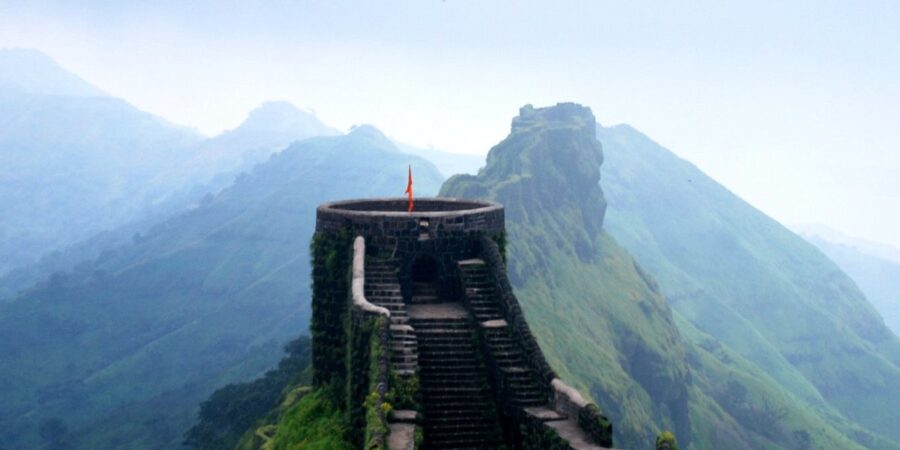 Rajgad Fort, located in the Sahyadri mountain range of Maharashtra, India, is a popular trekking destination for adventure enthusiasts. The fort, also known as the “King of Forts,” was built during the 17th century and served as the capital of the Maratha Empire under the rule of Chhatrapati Shivaji Maharaj. Today, the fort is a popular trekking destination, attracting trekkers from all over the world.
Rajgad Fort, located in the Sahyadri mountain range of Maharashtra, India, is a popular trekking destination for adventure enthusiasts. The fort, also known as the “King of Forts,” was built during the 17th century and served as the capital of the Maratha Empire under the rule of Chhatrapati Shivaji Maharaj. Today, the fort is a popular trekking destination, attracting trekkers from all over the world.
The trek to Rajgad Fort is challenging, covering a distance of approximately 13 kilometers and taking around 6-7 hours to complete. The trail is steep and rocky and requires specific fitness and stamina. However, the stunning views of the surrounding mountains and valleys make the trek worthwhile.
The Rajgad Fort holds great historical significance as it served as the capital of the Maratha Empire under the visionary leadership of the legendary warrior king, Chhatrapati Shivaji Maharaj. Built during the 17th century, the fort played a pivotal role in Shivaji’s strategic military operations and was the site of many crucial battles fought by the Marathas against the Mughal Empire.
The fort’s name, Rajgad, translates to “King’s Fort,” which is a fitting tribute to its royal past. It served as the administrative headquarters of the Maratha kingdom and witnessed several historic events that shaped Maharashtra’s history. The fort’s strategic location atop a hill provided a vantage point for monitoring the surrounding regions and symbolized the Maratha Empire’s power and resilience.
The trek starts at the base village of Gunjavane, which is about 60 kilometers from Pune. The village is accessible by road and is well-connected to major cities in Maharashtra. The trail starts with a gradual climb through dense forests and meadows. The trail then becomes steeper and more challenging as it approaches the fort.
As trekkers climb higher, they are treated to breathtaking views of the surrounding mountains and valleys. The trek also takes trekkers through a series of rock-cut steps and narrow passages, adding to the adventure and excitement of the trek.
The fort is magnificent, with its massive walls and fortifications. The fort has several entrances, each guarded by a large gate. The main entrance is located on the eastern side of the fort and is guarded by a large bastion. The fort also has several structures and ruins, including a temple dedicated to Lord Shiva, a granary, and several water cisterns.
Once trekkers reach the top of the fort, they are rewarded with stunning views of the surrounding mountains and valleys. The fort offers panoramic views of the Sahyadri mountain range; on clear days, one can even see the Torna Fort in the distance.
 The fort also has several exciting features, including a “Maha Darwaja,” a massive gate that is said to have been built to prevent elephants from entering the fort. The fort also has a “Padmavati Machi,” a cliff offering a stunning view of the surrounding mountains and valleys. Some of the major attractions along the trail each offer their own unique charm and appeal:
The fort also has several exciting features, including a “Maha Darwaja,” a massive gate that is said to have been built to prevent elephants from entering the fort. The fort also has a “Padmavati Machi,” a cliff offering a stunning view of the surrounding mountains and valleys. Some of the major attractions along the trail each offer their own unique charm and appeal:
- Pali Darwaza: The trek begins at the Pali Darwaza, the main entrance to the fort. This imposing gateway, adorned with intricate carvings, is a testament to the architectural brilliance of the Maratha era. As trekkers pass through the door, they enter a world steeped in history and grandeur.
- Chor Darwaza: The Chor Darwaza, or the Thief’s Gate, is another notable attraction on the trek. It gets its name from the hidden escape route that Shivaji Maharaj used during a surprise attack on the fort. This secret passage was ingeniously designed to confound and trap any intruders.
- Bale Killa: The fort’s highest point is known as Bale Killa or the Citadel. It offers a commanding view of the entire region, allowing trekkers to appreciate the strategic significance of Rajgad. The Bale Killa houses the ruins of various structures, including palaces, granaries, and water cisterns, which provide a glimpse into the glorious past of the Marathas.
- Padmavati Machi: Padmavati Machi is a picturesque plateau on the fort’s eastern side. It offers panoramic views of the Sahyadri ranges and the lush green valleys below. Many trekkers choose to rest and soak in the serene beauty of this spot before continuing their journey.
- Sanjeevani Machi: Sanjeevani Machi, on the fort’s western side, is a sprawling plateau that captivates visitors with its scenic charm. The gentle slopes, covered with wildflowers during the monsoon season, make it an ideal spot for a peaceful break amidst nature.
The trek down from the fort is equally challenging, and trekkers are advised to be cautious while descending. The trek ends at the base village of Gunjavane, where trekkers can rest and relax before heading back home.
The best time to embark on the Rajgad Fort trek is during the monsoon season, from June to September. The heavy rainfall during this period transforms the entire region into a lush green paradise, with cascading waterfalls and blooming wildflowers adding to the trek’s natural beauty. The cool and pleasant weather makes the ascent more comfortable, allowing trekkers to enjoy the journey to its fullest.
It is essential to note that the monsoon season can also make the trek trail slippery and challenging. Trekkers should come prepared with appropriate gear, including sturdy shoes, rainproof clothing, and trekking poles for stability.
 Preserving the natural and historical heritage of Rajgad Fort is of utmost importance. Trekkers must practice responsible trekking and leave no trace behind. The Maharashtra government and local authorities have implemented measures to ensure the fort’s conservation, and visitors need to respect and abide by these guidelines.
Preserving the natural and historical heritage of Rajgad Fort is of utmost importance. Trekkers must practice responsible trekking and leave no trace behind. The Maharashtra government and local authorities have implemented measures to ensure the fort’s conservation, and visitors need to respect and abide by these guidelines.
Furthermore, hiring local guides can enhance the trekking experience while contributing to the nearby communities’ livelihood. Local guides possess in-depth knowledge of the fort’s history, legends, and trekking routes, providing valuable insights and ensuring a safe and informative journey.
The Rajgad Fort trek in Maharashtra offers an enchanting blend of history, adventure, and natural beauty. From its historical significance as the capital of the Maratha Empire to the breathtaking views from its summit, every step of the trek unravels the grandeur and magnificence of the past. The trek to Rajgad Fort is a journey that takes trekkers back in time, allowing them to relive the glorious era of the Marathas while immersing themselves in the captivating beauty of the Sahyadris. So, lace up your boots, embrace the spirit of adventure, and embark on an unforgettable trek to Rajgad Fort, where history and nature converge in perfect harmony.





